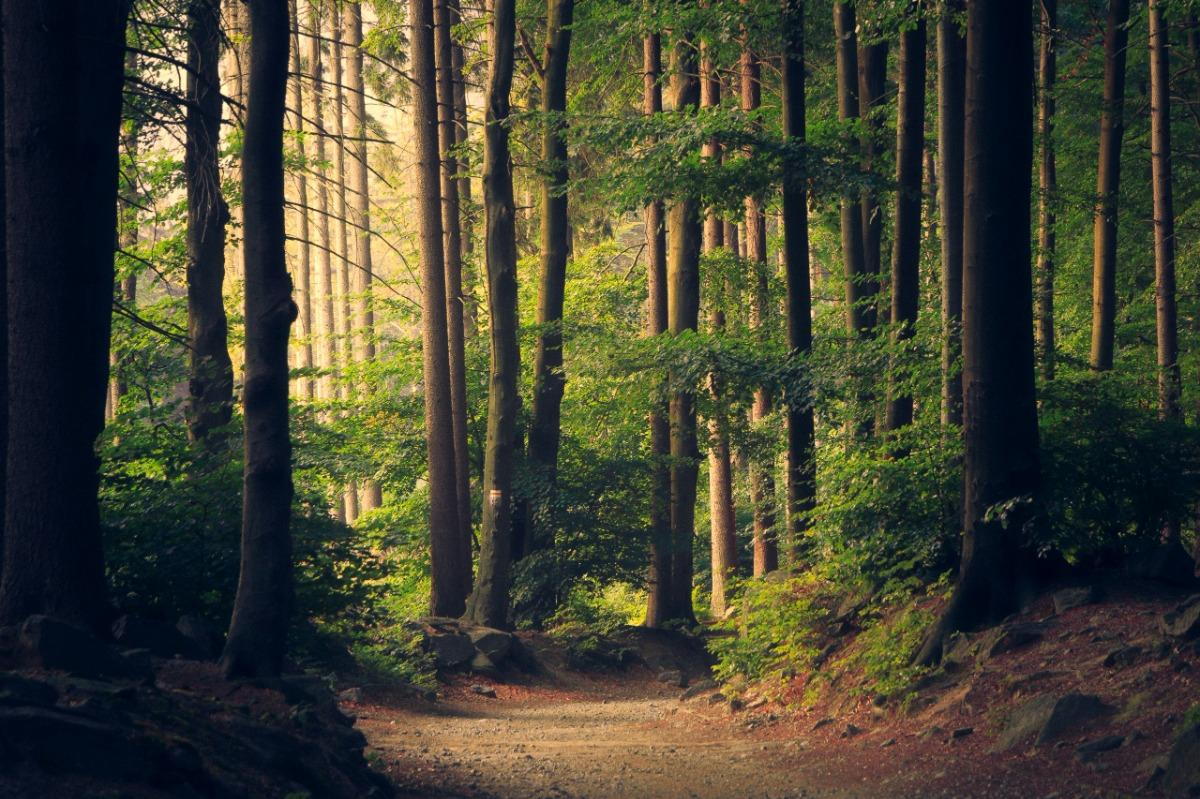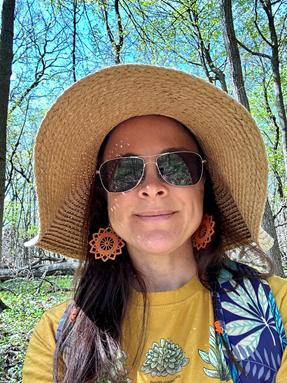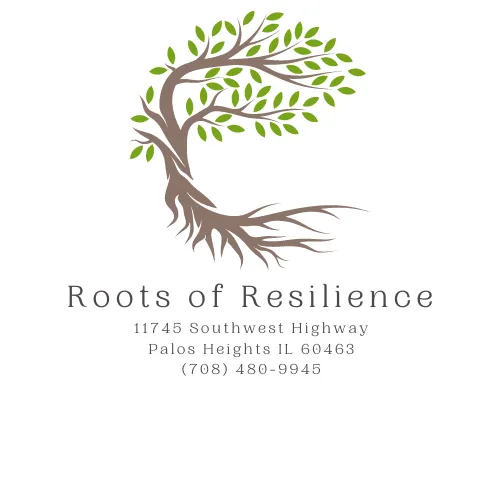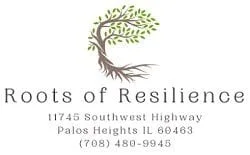Looking To Broaden Your Self-Care Practice: Part II Connecting with Nature

Welcome to our blog series highlighting alternative practices and approaches to self-care! Maybe you are in need of some additional self-care tools to manage stress & anxiety or interested in a new way to connect with your mind, body, spirit and nature. Our second guest is Kristy Belton, Certified Forest Therapy Guide, of Prairie Pathways.

What led you to become a certified forest therapy guide?
I have always felt most at home outside and had been looking for ways to deepen my relationship to “outer nature.” I was volunteering, mainly in restoration efforts, with the DuPage Forest Preserves, as well as supporting the work of The Conservation Foundation in different ways. I was also writing a newsletter column on gardening for conservation. While this was all gratifying work, I longed to guide people toward experiences where they, too, could feel at home outside and encounter the beauty, wonder and healing power of the natural world. So I allowed curiosity to guide me and forest therapy revealed itself as a welcoming and accessible way to do just that.
How have you seen spending time in and engaging with nature help people find a sense of peace and relaxation?
Multiple studies exist on the health and well-being effects of forest therapy (and time spent in nature in general). Since forest therapy is an invitational practice – you can modify the invitations that the guide provides if they do not feel good to you – it allows for a sense of ease on the walk. You know that you are accepted as you are and are empowered to trust yourself.
Moreover, bringing people back to their bodies through specific sensory invitations guides them away from the chatter of their mind and into the present. By being present we are freed from many of the stresses that accompany our past- or future-focused thoughts.
As a guide, I have witnessed people let down their guards and become vulnerable, playful, attentive and joyous. They are able to relax into who they are while being held by the natural world. Peace is very often the result of this type of encounter and process.
I also guide Writing W.I.L.D.™ experiences and outdoor yoga as ways to bring people back into relationship with their inner nature through practices in outer nature. Writing W.I.L.D.™ (writing with wonder, intuition, love and daring) is a walking journey that taps into various features of the land and self through writing invitations.
People are often surprised, whether or not they think of themselves as “writers,” to discover the creative expression that lies within them, yearning to get out. It is “nature” once again, as in forest therapy, who creates the supportive space for us to grow during these practices.
How can someone begin to incorporate nature into their self-care routines?
We must first remember that we are nature. We are animals. We co-evolved with other animals and other kingdoms and rely on the plant kingdom for our very existence. It is only in the past few thousand years that we have arrived at a place of separation.
Our ancestors had no word for “nature” – meaning something outside, “out there,” “separate” to us – because their understanding of the world, and their place within it, could not fathom such a sense of separation. (It is important to point out that not all peoples see humans as separate from the earth and other forms of life. Indigenous peoples the world over have a different cosmology and know we are not separate from that which sustains us).
Given how much of our life is spent indoors and on screens, it is challenging to remember we are nature. So an integral part of self-care is reframing. We have to begin to understand ourselves as part of something much greater than the physical body that we believe to be our “self.” We have to recognize that “out there” is really an integral part of “in here.” Our self-care is interwoven with the care of the earth we live upon.
So what can we do to begin the reframing? Start paying attention. Engage your senses. Notice how something smells; feel the breeze on your skin; observe the sounds around you; take pleasure in the simple joys that exist: dew drops on spiders webs; squirrels somersaulting; rose perfume; shapeshifting clouds; the particular call of a bird. Simply start noticing where you are in place and space.
This can be done on a walk or it can be done from a sit spot. A sit spot is an easily accessible place that we can habitually return to that allows us to observe life around us. Sit spots can be outdoors or indoors. What matters is that wherever we go, we make it a habit of engaging as many of our senses as possible to encounter the world. If we are indoors, for instance, we can open a window and close our eyes, asking, what do we hear? smell? We can pay attention to how the sun changes its height depending on the season; the direction of the wind; partnerships that exist among other species, etc.
The next step after paying attention is to intentionally relate to what you sense. It can be as simple as saying, “I see…I feel.” For example, “I see a plant growing through a crack in the pavement. I feel awe at where life is able to grow.” Or, “I hear the wind in the tree leaves. I feel a sense of excitement rush through me.”
Whatever it is, welcome it. Be neutral and do not place value judgements on what you are noticing and feeling. This practice allows us to remember that we are constantly affected – whether we are conscious of it or not – by our surroundings. We are not separate.
Relational practices can be deepened beyond the “I feel” exercise above by earth tending. Earth tending is care for something beyond ourselves that embraces the natural world. This can encompass anything from picking up litter to volunteering at local parks and preserves to gardening (an indoor plant in a pot will do, too) to engaging in conservation efforts and a whole host of possibilities in between! Choose what speaks to you and go with that. You will find that by deepening your relationship to “outer nature” in this way, your sense of self, belonging and love will expand.
What can someone expect when doing a forest therapy walk with you?
Most forest therapy walks have a “standard sequence” in terms of how we carry out the walk, but there is a lot of variety within the sequence. For instance, invitations change, as does the season, the weather, the climate and the land itself. The guide and the participants also influence the walk. No forest therapy walk is the same and I love that.
In terms of my guiding, I am on the playful side. I often have people say how they have not done a particular thing since childhood and how much they enjoyed doing it. I am also unafraid to show up as myself (which includes expressing my love for the land and sharing messages I receive while on a walk), which allows others to show up as themselves, too.
Most forest therapy walks end with a tea ceremony and I enjoy finding tucked away magical spots where we come together to share our experiences. I hope that people who journey with me leave with a sense of the sacred.
Are the calming benefits of forest therapy walking immediate?
It's difficult for most of us to go from our “doing” selves to our “being” selves.
I had mentioned earlier that there’s a standard sequence we follow, which means the first two invitations on a guided forest therapy walk (at least for those who trained with the Association of Nature and Forest Therapy [ANFT]) are always the same.
Amos Clifford, the founder of ANFT, observed through his years of forest therapy practice that those two invitations – pleasures of presence and what’s in motion – were necessary to provide people the space to “drop in.” Once people’s senses are engaged and they become embodied, ease seeps in.
Of course, everyone is different, and the slow pace of a forest therapy walk may be challenging for those who find it difficult to “switch off” and stop thinking about to-do lists (but it is probably those very people who need this type of practice!).
There’s also a good bit of research that shows how stress hormones and blood glucose levels drop, while “feel good” hormones, like dopamine, increase right after a forest therapy walk. So, yes, physical indicators exist to show that the benefits of forest therapy walks are immediate.
What are some things you wish others knew about forest therapy walking?
I wish others knew that forest therapy is one of the most accessible and welcoming practices to reconnect to self, to others and to the land. It’s hard to put into words how beautiful the practice is and how revelatory it can be. It’s not about “walking the talk.” It’s about walking the walk.
Make it a practice and see what paths unfold before you.
More About Kristy Belton
Kristy A. Belton, PhD is a forest therapy guide, creativity coach and author. She is the founder of Prairie Pathways, an organization that reconnects people to inner nature through rewilding practices. When she's not guiding people, you can find Kristy getting muddy in the garden, playing with paint and putting words to paper.

Welcome to our blog series highlighting alternative practices and approaches to self-care! Maybe you are in need of some additional self-care tools to manage stress & anxiety or interested in a new way to connect with your mind, body, spirit and nature. Our second guest is Kristy Belton, Certified Forest Therapy Guide, of Prairie Pathways.

What led you to become a certified forest therapy guide?
I have always felt most at home outside and had been looking for ways to deepen my relationship to “outer nature.” I was volunteering, mainly in restoration efforts, with the DuPage Forest Preserves, as well as supporting the work of The Conservation Foundation in different ways. I was also writing a newsletter column on gardening for conservation. While this was all gratifying work, I longed to guide people toward experiences where they, too, could feel at home outside and encounter the beauty, wonder and healing power of the natural world. So I allowed curiosity to guide me and forest therapy revealed itself as a welcoming and accessible way to do just that.
How have you seen spending time in and engaging with nature help people find a sense of peace and relaxation?
Multiple studies exist on the health and well-being effects of forest therapy (and time spent in nature in general). Since forest therapy is an invitational practice – you can modify the invitations that the guide provides if they do not feel good to you – it allows for a sense of ease on the walk. You know that you are accepted as you are and are empowered to trust yourself.
Moreover, bringing people back to their bodies through specific sensory invitations guides them away from the chatter of their mind and into the present. By being present we are freed from many of the stresses that accompany our past- or future-focused thoughts.
As a guide, I have witnessed people let down their guards and become vulnerable, playful, attentive and joyous. They are able to relax into who they are while being held by the natural world. Peace is very often the result of this type of encounter and process.
I also guide Writing W.I.L.D.™ experiences and outdoor yoga as ways to bring people back into relationship with their inner nature through practices in outer nature. Writing W.I.L.D.™ (writing with wonder, intuition, love and daring) is a walking journey that taps into various features of the land and self through writing invitations.
People are often surprised, whether or not they think of themselves as “writers,” to discover the creative expression that lies within them, yearning to get out. It is “nature” once again, as in forest therapy, who creates the supportive space for us to grow during these practices.
How can someone begin to incorporate nature into their self-care routines?
We must first remember that we are nature. We are animals. We co-evolved with other animals and other kingdoms and rely on the plant kingdom for our very existence. It is only in the past few thousand years that we have arrived at a place of separation.
Our ancestors had no word for “nature” – meaning something outside, “out there,” “separate” to us – because their understanding of the world, and their place within it, could not fathom such a sense of separation. (It is important to point out that not all peoples see humans as separate from the earth and other forms of life. Indigenous peoples the world over have a different cosmology and know we are not separate from that which sustains us).
Given how much of our life is spent indoors and on screens, it is challenging to remember we are nature. So an integral part of self-care is reframing. We have to begin to understand ourselves as part of something much greater than the physical body that we believe to be our “self.” We have to recognize that “out there” is really an integral part of “in here.” Our self-care is interwoven with the care of the earth we live upon.
So what can we do to begin the reframing? Start paying attention. Engage your senses. Notice how something smells; feel the breeze on your skin; observe the sounds around you; take pleasure in the simple joys that exist: dew drops on spiders webs; squirrels somersaulting; rose perfume; shapeshifting clouds; the particular call of a bird. Simply start noticing where you are in place and space.
This can be done on a walk or it can be done from a sit spot. A sit spot is an easily accessible place that we can habitually return to that allows us to observe life around us. Sit spots can be outdoors or indoors. What matters is that wherever we go, we make it a habit of engaging as many of our senses as possible to encounter the world. If we are indoors, for instance, we can open a window and close our eyes, asking, what do we hear? smell? We can pay attention to how the sun changes its height depending on the season; the direction of the wind; partnerships that exist among other species, etc.
The next step after paying attention is to intentionally relate to what you sense. It can be as simple as saying, “I see…I feel.” For example, “I see a plant growing through a crack in the pavement. I feel awe at where life is able to grow.” Or, “I hear the wind in the tree leaves. I feel a sense of excitement rush through me.”
Whatever it is, welcome it. Be neutral and do not place value judgements on what you are noticing and feeling. This practice allows us to remember that we are constantly affected – whether we are conscious of it or not – by our surroundings. We are not separate.
Relational practices can be deepened beyond the “I feel” exercise above by earth tending. Earth tending is care for something beyond ourselves that embraces the natural world. This can encompass anything from picking up litter to volunteering at local parks and preserves to gardening (an indoor plant in a pot will do, too) to engaging in conservation efforts and a whole host of possibilities in between! Choose what speaks to you and go with that. You will find that by deepening your relationship to “outer nature” in this way, your sense of self, belonging and love will expand.
What can someone expect when doing a forest therapy walk with you?
Most forest therapy walks have a “standard sequence” in terms of how we carry out the walk, but there is a lot of variety within the sequence. For instance, invitations change, as does the season, the weather, the climate and the land itself. The guide and the participants also influence the walk. No forest therapy walk is the same and I love that.
In terms of my guiding, I am on the playful side. I often have people say how they have not done a particular thing since childhood and how much they enjoyed doing it. I am also unafraid to show up as myself (which includes expressing my love for the land and sharing messages I receive while on a walk), which allows others to show up as themselves, too.
Most forest therapy walks end with a tea ceremony and I enjoy finding tucked away magical spots where we come together to share our experiences. I hope that people who journey with me leave with a sense of the sacred.
Are the calming benefits of forest therapy walking immediate?
It's difficult for most of us to go from our “doing” selves to our “being” selves.
I had mentioned earlier that there’s a standard sequence we follow, which means the first two invitations on a guided forest therapy walk (at least for those who trained with the Association of Nature and Forest Therapy [ANFT]) are always the same.
Amos Clifford, the founder of ANFT, observed through his years of forest therapy practice that those two invitations – pleasures of presence and what’s in motion – were necessary to provide people the space to “drop in.” Once people’s senses are engaged and they become embodied, ease seeps in.
Of course, everyone is different, and the slow pace of a forest therapy walk may be challenging for those who find it difficult to “switch off” and stop thinking about to-do lists (but it is probably those very people who need this type of practice!).
There’s also a good bit of research that shows how stress hormones and blood glucose levels drop, while “feel good” hormones, like dopamine, increase right after a forest therapy walk. So, yes, physical indicators exist to show that the benefits of forest therapy walks are immediate.
What are some things you wish others knew about forest therapy walking?
I wish others knew that forest therapy is one of the most accessible and welcoming practices to reconnect to self, to others and to the land. It’s hard to put into words how beautiful the practice is and how revelatory it can be. It’s not about “walking the talk.” It’s about walking the walk.
Make it a practice and see what paths unfold before you.
More About Kristy Belton
Kristy A. Belton, PhD is a forest therapy guide, creativity coach and author. She is the founder of Prairie Pathways, an organization that reconnects people to inner nature through rewilding practices. When she's not guiding people, you can find Kristy getting muddy in the garden, playing with paint and putting words to paper.



